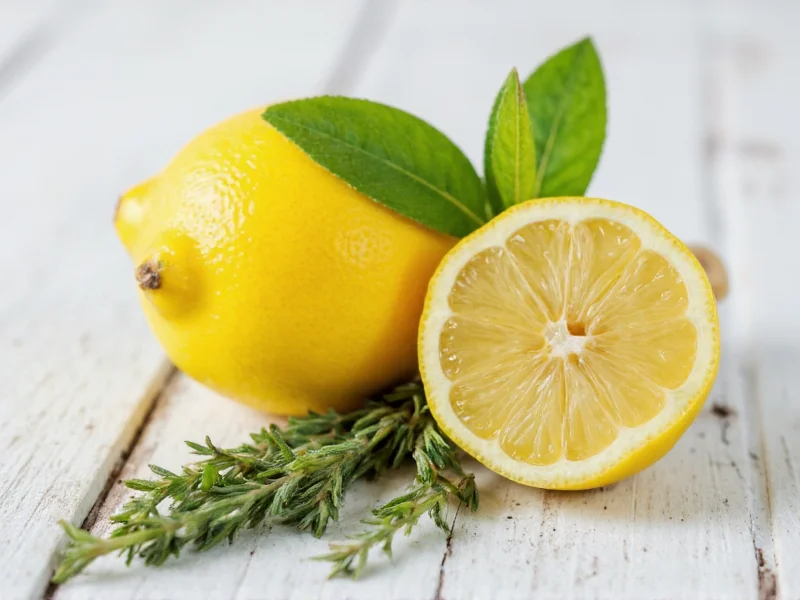When exploring lemon and thyme flavor combinations, you're tapping into one of cooking's most versatile duos. This dynamic pairing works because lemon's vibrant citrus notes cut through richness while thyme's subtle herbal complexity adds depth. Professional chefs consistently reach for this combination when crafting dishes that require balance between brightness and earthiness.
The Science Behind the Perfect Pairing
Lemon contains high levels of citric acid and limonene, which stimulate saliva production and cleanse the palate. Thyme, meanwhile, contains thymol and carvacrol—compounds that provide its distinctive earthy, slightly floral character. When combined, these elements create what food scientists call flavor layering, where neither ingredient dominates but instead enhances the other's best qualities.
This pairing follows the culinary principle of complementary contrast—combining elements with opposing characteristics that ultimately create harmony. The acidity of lemon lifts thyme's herbal notes, while thyme's earthiness prevents lemon from tasting one-dimensionally sour.
Top Culinary Applications for Lemon and Thyme
Understanding how to use lemon and thyme together properly can transform ordinary dishes into extraordinary meals. Here are the most effective applications:
| Dish Category | Best Application Method | Proportion Ratio |
|---|---|---|
| Poultry | Under skin with olive oil | 3 lemon:1 thyme |
| Fish | As finishing garnish | 2 lemon:1 thyme |
| Roasted Vegetables | Tossed before roasting | 1 lemon:1 thyme |
| Compound Butter | Blended into softened butter | 4 lemon:3 thyme |
| Vinaigrettes | Emulsified into dressing | 5 lemon:2 thyme |
Mastering Lemon and Thyme Preparation Techniques
For optimal results with lemon thyme flavor pairing, proper preparation matters. Always use fresh ingredients when possible—dried thyme lacks the nuanced flavor profile that complements lemon so well. When working with lemons, zest before juicing to capture the aromatic oils in the peel, which contain the most concentrated lemon flavor.
For thyme, strip leaves from stems by running your fingers downward—this prevents bitter stem pieces from contaminating your dish. Add thyme early in cooking for infused dishes like stews, but incorporate lemon juice near the end to preserve its bright character. When making lemon and thyme chicken recipes, tuck whole sprigs under poultry skin for gradual flavor release during roasting.
Three Essential Lemon and Thyme Recipes
1. Classic Lemon-Thyme Roasted Chicken
This foundational mediterranean lemon thyme recipe serves four and requires:
- 1 whole chicken (3-4 lbs)
- 3 tbsp fresh thyme leaves
- Zest and juice of 2 lemons
- 4 garlic cloves, minced
- 3 tbsp olive oil
- Salt and pepper to taste
Combine thyme, lemon zest, garlic, olive oil, salt, and pepper. Loosen chicken skin and rub mixture underneath. Place lemon halves and remaining thyme inside cavity. Roast at 425°F for 60-75 minutes until internal temperature reaches 165°F.
2. Lemon-Thyme Compound Butter
Perfect for finishing steaks or fish, this lemon thyme compound butter recipe keeps refrigerated for two weeks:
- 1 cup unsalted butter, softened
- Zest of 2 lemons
- 2 tbsp fresh thyme, finely chopped
- 1 tbsp lemon juice
- 1 garlic clove, minced
- Pinch of sea salt
Mix all ingredients until thoroughly combined. Roll into a log using parchment paper, then refrigerate until firm. Slice coins to melt over hot dishes.
3. Spring Vegetable Medley with Lemon-Thyme Vinaigrette
This light side dish showcases fresh lemon and thyme combinations beautifully:
- 2 cups asparagus, trimmed
- 1 cup sugar snap peas
- 1 cup baby carrots
- 3 tbsp olive oil
- Zest and juice of 1 lemon
- 1 tbsp fresh thyme
- 1 tsp Dijon mustard
Blanch vegetables for 2 minutes, then shock in ice water. Whisk dressing ingredients. Toss vegetables with dressing just before serving.
Storage Tips for Maximum Freshness
To maintain peak flavor for your lemon and thyme recipes, proper storage is essential. Store unwashed thyme upright in a glass with an inch of water, covered loosely with a plastic bag in the refrigerator—it should stay fresh for 10-14 days. For lemons, keep at room temperature for up to a week for easiest zesting and juicing, or refrigerate in the crisper drawer for up to three weeks.
Never store cut lemons near strong-smelling foods as they readily absorb odors. For longer preservation, freeze lemon zest in ice cube trays with water or oil, and freeze thyme sprigs on a baking sheet before transferring to freezer bags.
Common Mistakes to Avoid
Many home cooks make these errors with lemon and thyme chicken recipes and other applications:
- Adding lemon juice too early in cooking, causing bitterness
- Using dried thyme instead of fresh for finishing dishes
- Over-zesting lemons, including the bitter white pith
- Not adjusting ratios based on specific dish requirements
- Using old, dried-out lemons with diminished flavor
Remember that Meyer lemons offer a sweeter profile that works exceptionally well with thyme in desserts and delicate fish dishes, while standard Eureka lemons provide the classic tartness ideal for heartier applications.
Variations and Substitutions
When creating your own lemon thyme flavor pairing guide, consider these variations:
- Add a touch of honey for sweet-savory balance in glazes
- Combine with garlic for classic Mediterranean profiles
- Mix with olive oil and salt for versatile finishing oil
- Incorporate into mayonnaise for sandwiches and dips
- Blend with cream for luxurious pasta sauces
If thyme isn't available, oregano or marjoram make acceptable substitutes, though the flavor profile shifts noticeably. For lemon alternatives, lime works in seafood applications, while orange provides a sweeter profile better suited to desserts.
Final Thoughts on Mastering This Classic Pairing
The enduring popularity of lemon and thyme in professional kitchens stems from their remarkable versatility and complementary nature. By understanding the proper ratios, preparation techniques, and application methods outlined in this lemon and thyme flavor pairing guide, you can elevate everyday cooking to restaurant-quality results. Whether you're preparing simple weeknight dinners or special occasion meals, this dynamic duo consistently delivers balanced, sophisticated flavors that please diverse palates.











 浙公网安备
33010002000092号
浙公网安备
33010002000092号 浙B2-20120091-4
浙B2-20120091-4